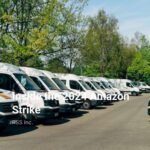
The 2024 Amazon strike marked one of the most pivotal moments in recent U.S. labor history. What began as a standoff between Amazon and the International Brotherhood of Teamsters quickly escalated into a national demonstration involving delivery drivers across major metro areas. This article explores the strike’s causes, scope, worker demands, legal battles, and its broader implications for labor in the gig economy.
What Led to the Amazon Strike?
At the heart of the December 2024 strike was a breakdown in labor relations between Amazon and thousands of its delivery drivers—many of whom are technically employed by Delivery Service Partners (DSPs), third-party contractors that manage “last mile” logistics for the e-commerce giant.
For months leading up to the strike, the Teamsters union had been pressing Amazon to recognize and negotiate with organized workers. The tipping point came when the company refused to meet a December 15 deadline set by the Teamsters to begin talks. On December 19, thousands of drivers and warehouse workers across several Amazon distribution hubs initiated a strike.
The movement was concentrated in major U.S. cities like New York, Chicago, Atlanta, and San Francisco—regions with high Amazon package volume and key distribution facilities. Yet, its message resonated far beyond these locations.
The Role of Delivery Service Partners (DSPs)
Amazon’s Delivery Service Partner model complicates labor disputes. While Amazon oversees everything from the technology to the routes and uniforms, DSPs technically employ the drivers. This structure allows Amazon to claim it is not directly responsible for many of the workers’ grievances.
However, drivers argue that Amazon exercises control over their daily routines, package quotas, and performance monitoring—functions typically carried out by an employer. This gray area formed a central battleground in the 2024 strike, raising questions about who is truly accountable for worker conditions.
Key Worker Demands
The Teamsters’ list of demands centered around the following core issues:
- Union recognition: Workers wanted Amazon to formally recognize the union and begin contract negotiations.
- Better pay: Many drivers report making less than $20 per hour while facing increasing demands during peak delivery seasons.
- Improved working conditions: Workers cited unrealistic delivery quotas, lack of access to restrooms, inadequate break time, and long hours.
- Job security: With no formal employment ties to Amazon, DSP drivers could be fired with little recourse.
- Health and safety: Drivers detailed stories of injuries, unsafe driving conditions, and extreme pressure to meet delivery deadlines.
Many of these demands are not new. Labor activists have been warning for years about Amazon’s labor practices, but the December strike represented the largest and most organized pushback to date.
Amazon’s Official Response
Amazon issued a statement claiming the strike was limited in scope and involved a small portion of its logistics network. The company emphasized that most drivers are employed by independent businesses and that Amazon is not obligated to negotiate with the Teamsters.
Executives were quick to reassure customers that holiday deliveries would not be impacted. Internally, however, the company mobilized to ensure operations continued smoothly, reassigning delivery routes and increasing overtime for non-striking staff.
Despite Amazon’s confidence, the strike attracted national headlines and generated widespread discussion on social media, putting intense scrutiny on the company’s treatment of its labor force.
Public Support and Political Reactions
The strike drew support from elected officials, particularly those aligned with progressive labor movements. Several U.S. senators issued statements of solidarity with the striking drivers, and local officials in affected cities urged Amazon to engage in fair labor practices.
Protestors staged demonstrations outside Amazon facilities, and a few sympathetic groups organized consumer boycotts during peak holiday shopping periods. Labor unions across industries also voiced their backing, seeing the strike as part of a larger reckoning with corporate labor models that prioritize cost-cutting over worker well-being.
The Legal Landscape: Who Employs Amazon’s Drivers?
A central legal question emerging from the strike is: who is the actual employer? While DSPs sign contracts with Amazon, the company retains deep operational control, including performance expectations, branding, and routing algorithms.
Labor law experts point to a growing body of cases where courts have scrutinized similar arrangements in industries like ride-sharing and food delivery. The outcome of these debates could reshape how gig economy labor is regulated in the U.S.
In parallel, the National Labor Relations Board (NLRB) filed a complaint against Amazon, alleging that it engaged in unfair labor practices by failing to bargain in good faith. This complaint, while still under review, added legitimacy to the Teamsters’ push and intensified legal pressure on Amazon.
The Human Side: Stories from the Picket Line
Striking drivers shared powerful testimonials about the pressures they faced on the job. Many described 10- to 12-hour shifts with minimal breaks, unrealistic quotas of 300+ packages per day, and little to no interaction with their employers.
Some reported urinating in bottles due to a lack of accessible restrooms, while others highlighted injuries caused by rushing through poorly maintained routes. The emotional and physical toll of the job, especially during peak delivery seasons, fueled the urgency of the strike.
One striking driver in Atlanta stated, “We’re treated like robots with no room for error. If you fall behind, you’re out. And yet it’s Amazon who controls everything.”
Broader Implications for the Logistics Industry
The 2024 Amazon strike didn’t just disrupt one company—it sent shockwaves through the logistics sector. Other companies that rely on subcontracted labor, such as FedEx Ground and Instacart, began evaluating their own practices in anticipation of potential worker actions.
The strike also reignited debate about the structure of modern labor, particularly the rise of “fissured employment,” where large corporations outsource labor to shield themselves from responsibility while maintaining operational control.
If Amazon is forced to change how it interacts with DSP drivers, it could set a precedent for labor reform across the tech and logistics industries.
Consumer Awareness and Responsibility
Many consumers who rely on Amazon’s rapid delivery services remain unaware of the labor force behind each package. The strike prompted greater public awareness of the human cost of convenience.
Some advocacy groups encouraged customers to support local businesses or delay non-essential purchases during the strike. Others called for transparency from Amazon, such as publishing working condition metrics and improving communication with its delivery network.
While no mass boycott took hold, the event helped consumers realize that next-day shipping often comes at a cost borne by frontline workers.
What Happens Next?
As of early 2025, negotiations between the Teamsters and Amazon have not resulted in a formal agreement. Some DSPs reportedly reached deals independently, but the broader demands for union recognition and nationwide standards remain unresolved.
Labor advocates expect continued organizing efforts and potential legal reforms, particularly as the NLRB evaluates Amazon’s employment structure. Several lawsuits are also underway, challenging Amazon’s designation of drivers as contractors rather than employees.
Looking forward, the Teamsters are planning additional actions in the spring, and some cities have proposed legislation that would give gig economy workers greater protections.
The Long-Term Outlook
The 2024 Amazon strike could prove to be a turning point in how America thinks about labor in the digital age. It exposed the fragility of the contractor model, the limits of current labor law, and the deep dissatisfaction among frontline workers.
For Amazon, the strike represents a branding challenge as much as a logistical one. The company must balance efficiency with ethics, especially as public sentiment around corporate accountability continues to evolve.
For workers, the strike demonstrated the power of collective action—even in fragmented, tech-driven workplaces. And for policymakers, it raised urgent questions about how to ensure fair labor practices in a world where the lines between employer and contractor are increasingly blurred.









